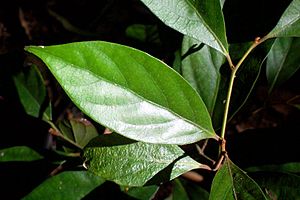Endiandra facts for kids
Quick facts for kids Endiandra |
|
|---|---|
 |
|
| Endiandra pubens, leaf | |
| Scientific classification |
|
| Kingdom: | Plantae |
| Clade: | Tracheophytes |
| Clade: | Angiosperms |
| Clade: | Magnoliids |
| Order: | Laurales |
| Family: | Lauraceae |
| Genus: | Endiandra R.Br. |
| Species | |
|
Over 100 |
|
| Synonyms | |
|
|
Endiandra is a group of about 100 different kinds of plants, mostly trees. They belong to the Lauraceae family, also known as the laurel family. People sometimes call them "walnut" trees. But they are not related to the walnuts you might eat, which are in a different family called Juglandaceae.
Contents
What are Endiandra Plants Like?
Endiandra plants are mostly shrubs and trees. Their leaves often look like laurel leaves. They have flowers that can produce both male and female parts. These flowers usually grow into a large, tasty berry. The berries can be round or oval-shaped. Animals and birds help spread the seeds from these berries.
Where Do Endiandra Plants Live?
You can find Endiandra plants in many places. They grow across Southeast Asia, Australia, and into the western Pacific Ocean. They are evergreen trees, meaning they keep their leaves all year long. In Australia, 38 different types of Endiandra grow only there. Some Australian species, like Endiandra globosa and Endiandra floydii, are quite rare.
How Endiandra Plants Survived History
Fossils show that Endiandra plants used to grow in even more places. This was before the glaciations, which were very cold periods. During those times, the climate was warmer and wetter. As the Earth got colder and drier, Endiandra plants moved to places with milder climates. These included islands and wetter mountain areas.
When the last ice age ended, Endiandra plants spread out again. Many of these plants are like living fossils. They are survivors from ancient types of vegetation that once covered much of the world. This included Australia, South America, and other lands. These areas used to be much more humid and warm.
Even though warm cloud forests disappeared during the ice ages, they grew back when the weather improved. Most cloud forests have moved back and forth over many geological eras. Their species adapted to warm and wet conditions. They were sometimes replaced by plants that could handle cold or dry weather. Many old species died out because they could not cross new oceans, mountains, or deserts. But others found safe places to survive, like coastal areas and islands.
Some Endiandra species are good at living in dry tropical forests. This includes Monsoon forests. Some Endiandra plants look similar to other plants. This is because they have adapted to similar environments. For example, some look like plants from Laurel forests. Their leaves are like laurel leaves, and birds often eat and spread their berries. Some Endiandra even live in very wet places.
Some species are in danger of disappearing. Others live in very specific small areas. Most Endiandra species have formed new types because they grew in different places. But some groups are very old, going back to the ancient continent of Gondwana. Other groups spread out quickly when the climate was good. These groups have wide distributions and only a few close relatives. This shows they have changed recently.
Who Eats Endiandra Fruits?
Many Endiandra species have fruits that can be eaten. Some birds and bats that eat only fruit swallow the whole fruit. They then spit out the seeds without chewing them. This helps spread the seeds. Other animals swallow the fruit and the seed passes through their body whole.
Many birds rely on these fruits for food. This includes birds from the families Cotingidae, Columbidae (doves), Trogonidae (trogons), Turdidae, and Toucans. The fruits are also a very important food for Palaeognathae, which are ancient types of birds. Seed dispersal for some Endiandra species is also done by fishes and large and small mammals. These can include Pachyderms (like elephants), Bovids (like cows), monkeys, tree-dwelling rodents, porcupines, or possums.
Types of Endiandra Species
Here are some selected species of Endiandra:
- Endiandra compressa – Found in New South Wales & Queensland, Australia
- Endiandra discolor – Found in New South Wales & Queensland, Australia
- Endiandra floydii – Found in New South Wales & Queensland, Australia
- Endiandra globosa – Found in New South Wales & Queensland, Australia
- Endiandra hayesii – Found in New South Wales & Queensland, Australia
- Endiandra hypotephra – Found in Queensland, Australia
- Endiandra introrsa – Found in New South Wales & Queensland, Australia
- Endiandra muelleri – Found in New South Wales & Queensland, Australia
- Endiandra pubens – Found in New South Wales & Queensland, Australia
- Endiandra sieberi – Found in New South Wales & Queensland, Australia
- Endiandra virens – Found in New South Wales & Queensland, Australia
-
Endiandra muelleri bracteata leaves
-
Large fruit of Endiandra globosa
-
Small tree of Endiandra introrsa
See also
 In Spanish: Endiandra para niños
In Spanish: Endiandra para niños





